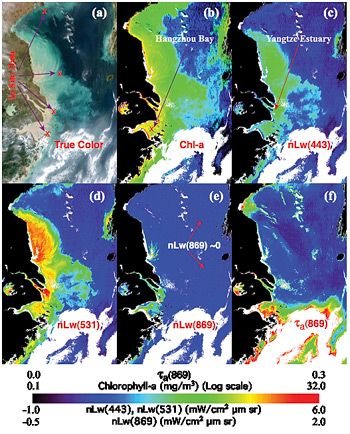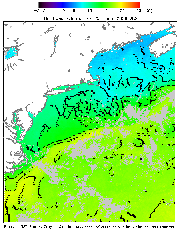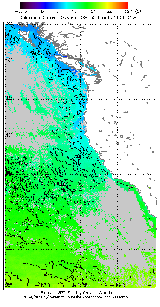
STAR News & Events - 2007 ArchiveDr. Menghua Wang Named NOAA Employee of the Month for July 2007
Ocean color data is an invaluable coastal management tool, providing improved understanding, monitoring and prediction of biological, biogeochemical and ecological processes and phenomena in coastal regions. Ocean color data and derived products are currently used within NOAA for a number of important applications, including production of the NOAA Harmful Algal Bloom Bulletins. One of the primary challenges in working effectively with ocean color data in coastal regions is that coastal waters are typically turbid and optically complex. This complexity leads to a spurious ocean signal that is not removed using what has been the standard atmospheric correction approach, producing significant errors in the derived ocean color products. Dr. Wang's research has provided a method to deal with this problem, and he has published two significant papers in March 2007 describing this approach and demonstrating how it leads to improved ocean color products in coastal regions. His approach has now been integrated into the standard NASA MODIS ocean color data processing software package, and will soon be incorporated by OSDPD into their operational processing system. Figure 1. China's East Coast - October 19, 2003
Figure 1 shows an example of the MODIS-derived ocean color products in the China east coastal region using the SWIR approach. Fig. 1(a) is a MODIS Aqua true color image along the China east coastal region acquired on October 19, 2003. This image shows very turbid waters along the China east coastal region, demonstrating the impact of large concentrations of suspended sediment on the color of these waters. Figs. 1(b)-1(f) are images of the MODIS-derived chlorophyll-a (Chl-a), normalized water-leaving radiance at wavelengths 443, 531, and 869 nm, and aerosol optical thickness at 869 nm, respectively. The Chl-a concentration (Fig. 1(b)) is scaled logarithmically from 0.1 to 32 (mg/m3), while the values of water-leaving radiance for band 443 and 531 nm (Figs. 1(c) and 1(d)) are scaled linearly from -1 to 6 (mW cm-2 μm-1 sr-1) and from -0.5 to 2 (mW cm-2 μm-1 sr-1) for the 869 nm band (Fig. 1(e)). Value of aerosol optical thickness in Fig. 1(f) is scaled from 0 to 0.3. It is noted that, along the China east coastal region, the MODIS-derived water-leaving radiance increases with increase of the wavelength from the blue to the green band, and values for some regions actually peak at the red band (Wang et al., 2007). This is a typical characteristic of the sediment-dominated waters. It is particularly noted that the NIR ocean contributions are quite significant, e.g., at the Hangzhou Bay region the average NIR water-leaving radiance values can reach to ~2.5 (mW cm-2 μm-1 sr-1) in the boreal winter (Wang et al., 2007). References:Wang, M. (2007), Remote sensing of the ocean contributions from ultraviolet to near-infrared wavelengths using the shortwave infrared bands: simulations, Appl. Opt., 46, 1535-1547. Wang, M. and W. Shi (2005), Estimation of ocean contribution at the MODIS near-infrared wavelengths along the east coast of the U.S.: Two case studies, Geophys. Res. Lett., 32, L13606, doi:10.1029/2005GL022917. Wang, M., J. Tang, and W. Shi (2007), MODIS-derived ocean color products along the China east coastal region, Geophys. Res. Lett., 34, L06611, doi:10.1029/2006GL028599. Tim Mavor Named NOAA Team Member of the Month for April 2007
In 2006, Tim has made a significant contribution toward accomplishing NOAA's mission. He successfully completed transition of the GOES Sea Surface Temperature Frontal product to operations. The product became operational in December 2006. It was Tim's persistence and initiative at developing the SST fronts product that made it possible. He saw a new application for existing data and made the data more useful for ocean applications. SST fronts are one of the main ocean regions for commercial and sports fisheries. The satellite-derived products generated by the NOAA CoastWatch, West Coast Regional Node, offer useful information to data customers in easily accessible formats. The products are utilized by a wide range of users, including members of the scientific community, managers, fishing men and women, educators, and the interested public. The Oceanic Front Probability Index describes the probability density of sea surface temperature front formation occurring off the coasts of California, Oregon, and Washington, based on data from the imagers carried aboard the NOAA GOES satellites. Fronts are often accompanied by surface convergence and influence surface flow (Bowman, 1978), and play an important role in upper ocean processes. Fronts can impact ocean fisheries, for example, by influencing the spatial distribution of biological productivity and by controlling the accumulation of marine debris, which serves as a beacon to higher trophic levels. Oceanic fronts are an important part of the California Current System, and are vital to the understanding and management of fisheries within this system. A recent paper (Castelao et al., 2005) evaluated and used the Oceanic Front Probability Index in their study of the topographical and seasonal influences on the northern California Current System off the coast of Oregon. Specific applications include use in the selection of Marine Protected Areas within the National Marine Sanctuaries, as well as inclusion as a core data set for the West Coast Regional Associations. Past News Items |
|
 Dr. Wang has been a research oceanographer at STAR since 2005.
Dr. Wang has been a research oceanographer at STAR since 2005.
 The China east coastal region contains some of the
most consistently highly turbid coastal waters to be found anywhere.
For turbid waters, standard MODIS data processing often produces
significant errors in the derived ocean color products due to
significant ocean water-leaving radiance contributions at the two near-
infrared (NIR) bands. The shortwave infrared (SWIR) atmospheric
correction approach has been developed (Wang, 2007) and demonstrated in
various coastal regions (e.g., the U.S. and China east coastal regions)
using MODIS data (Wang & Shi, 2005; Wang et al., 2007).
The China east coastal region contains some of the
most consistently highly turbid coastal waters to be found anywhere.
For turbid waters, standard MODIS data processing often produces
significant errors in the derived ocean color products due to
significant ocean water-leaving radiance contributions at the two near-
infrared (NIR) bands. The shortwave infrared (SWIR) atmospheric
correction approach has been developed (Wang, 2007) and demonstrated in
various coastal regions (e.g., the U.S. and China east coastal regions)
using MODIS data (Wang & Shi, 2005; Wang et al., 2007). STAR
congratulates Tim Mavor, NOAA
Team Member of the Month for April 2007. Tim has been a contractor with
STAR since August 1999.
During these 7+ years, he successfully met all his performance goals.
Tim is an exceptional colleague, always
available and willing to help to his fellow co-workers. He is highly
regarded by his peers and supervisors.
STAR
congratulates Tim Mavor, NOAA
Team Member of the Month for April 2007. Tim has been a contractor with
STAR since August 1999.
During these 7+ years, he successfully met all his performance goals.
Tim is an exceptional colleague, always
available and willing to help to his fellow co-workers. He is highly
regarded by his peers and supervisors.
